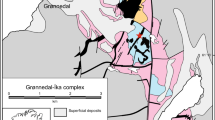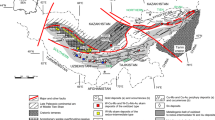Abstract
Iron-oxide–Cu–Au deposits, particularly those formed in deeper level (plutonic) environments, are commonly characterized by regional scale sodic(–calcic) alteration, which typically formed pre- or syn-Cu–Au mineralization. The sodic(–calcic) assemblages include albite, scapolite, pyroxene, actinolite, apatite, titanite, epidote and calcite. The consistent presence of coexisting hypersaline aqueous and CO2-rich fluids in minerals from sodic(–calcic) alteration and associated Fe-oxide–Cu–Au deposits is the result of unmixing of H2O–CO2–NaCl ± CaCl2–KCl magmatic fluids. Experimental evidence indicates that the Na/(Na + K) ratio of fluids in equilibrium with two alkali feldspars in CO3 2−-bearing parent fluids would be significantly higher than in unmixed chloride-bearing aqueous fluids. Therefore, fluid unmixing caused by decreases in temperature and/or pressure, will result in albitization of wall rocks, as is observed in most deeper level Fe-oxide–Cu–Au deposits. This alteration style may be succeeded by K-feldspathization with decreasing temperature because of the increase in equilibrium Na/(Na + K) in chloride-bearing fluids buffered by alkali feldspars.
Similar content being viewed by others
Author information
Authors and Affiliations
Additional information
Received: 26 May 1999 / Accepted: 8 June 2000
Rights and permissions
About this article
Cite this article
Pollard, P. Sodic(–calcic) alteration in Fe-oxide–Cu–Au districts: an origin via unmixing of magmatic H2O–CO2–NaCl ± CaCl2–KCl fluids. Mineral. Deposita 36, 93–100 (2001). https://doi.org/10.1007/s001260050289
Issue Date:
DOI: https://doi.org/10.1007/s001260050289




